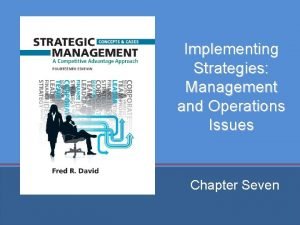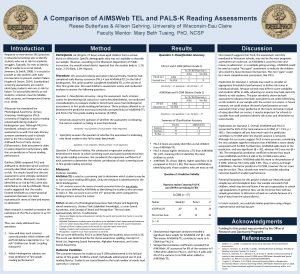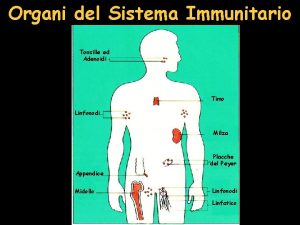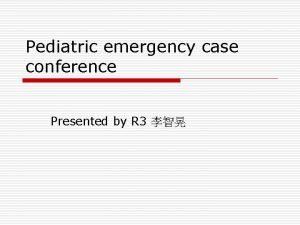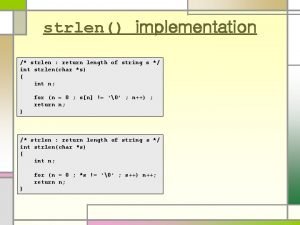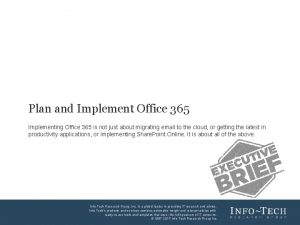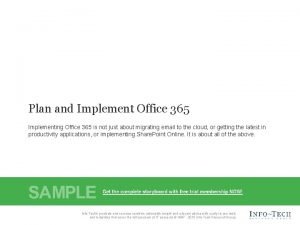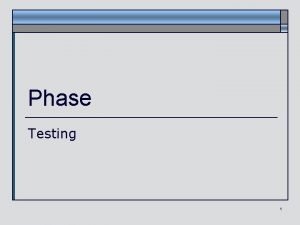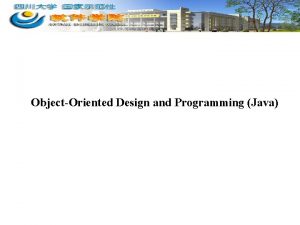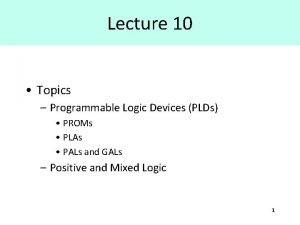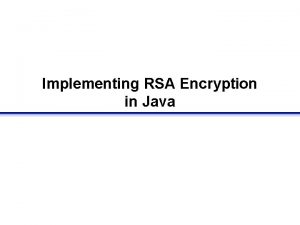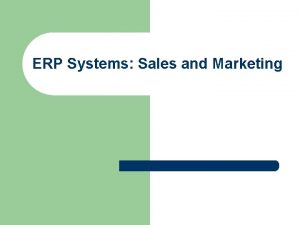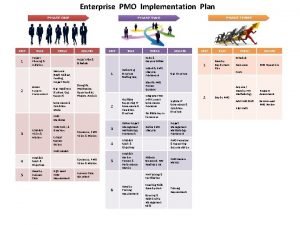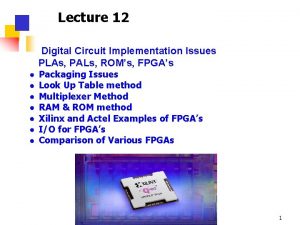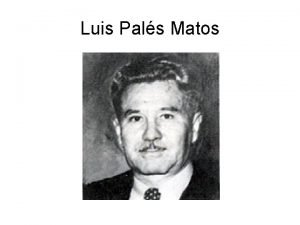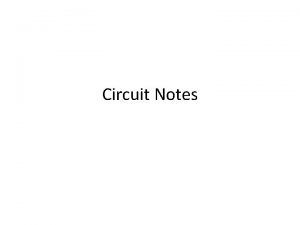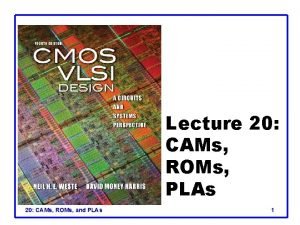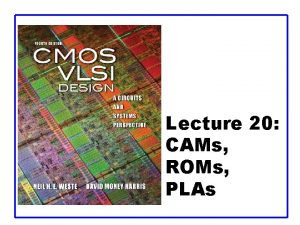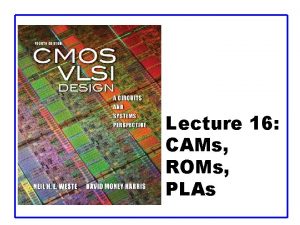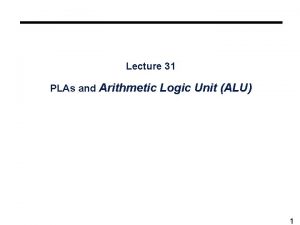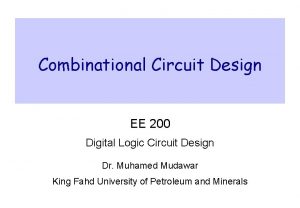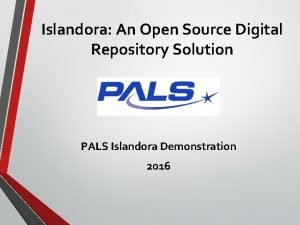Lecture 12 Digital Circuit Implementation Issues PLAs PALs



















































![TABLE 5. 2 ACT 3 timing parameters* [1] Fanout Family Delay* 1 2 3 TABLE 5. 2 ACT 3 timing parameters* [1] Fanout Family Delay* 1 2 3](https://slidetodoc.com/presentation_image_h2/c8022f3fd71a7da871df32e2aef12a1a/image-52.jpg)
![TABLE 5. 3 ACT 3 Derating factors* [1] Temperature T J ( junction) / TABLE 5. 3 ACT 3 Derating factors* [1] Temperature T J ( junction) /](https://slidetodoc.com/presentation_image_h2/c8022f3fd71a7da871df32e2aef12a1a/image-53.jpg)

























![FPGAs…. [1] Company General Architecture Logic Block Type Programming Technology Xilinx Symmetrical Array Look-up FPGAs…. [1] Company General Architecture Logic Block Type Programming Technology Xilinx Symmetrical Array Look-up](https://slidetodoc.com/presentation_image_h2/c8022f3fd71a7da871df32e2aef12a1a/image-79.jpg)

![Classic Package Hierarchy [Intel Corp. ] ~. 040” ~. 012“ Silicon Die Package Board Classic Package Hierarchy [Intel Corp. ] ~. 040” ~. 012“ Silicon Die Package Board](https://slidetodoc.com/presentation_image_h2/c8022f3fd71a7da871df32e2aef12a1a/image-81.jpg)


















![References [1] Michael J. S. Smith, “Application-Specific Integrated Circuits, ” Addison Wesley ISBN 0 References [1] Michael J. S. Smith, “Application-Specific Integrated Circuits, ” Addison Wesley ISBN 0](https://slidetodoc.com/presentation_image_h2/c8022f3fd71a7da871df32e2aef12a1a/image-100.jpg)







- Slides: 107

Lecture 12 · · · · Digital Circuit Implementation Issues PLAs, PALs, ROM’s, FPGA’s Packaging Issues Look Up Table method Multiplexer Method RAM & ROM method Xilinx and Actel Examples of FPGA’s I/O for FPGA’s Comparison of Various FPGAs 1

Back to Design Cycle • Defining system requirements • Making architectural decisions • Decisions on Hierarchy, Regularity, Locality • Comprehensive design of units • Planning for implementation • Planning for verification • Estimating System Performance • Implementation Technology Decision • Measuring system performance • Implementation 2

Names associated with this field : PLD… PAL, PLA, FPLA SPLD, CPLD GA, MPGA, ASIC, Full Custom , Semi Custom, ROM, PROM, EEPROM, FPGA, LCA, VLSI, ULSI, GSI, MCM, SOC, No. C FPOA (Field Programmable Object Array) e. FPGA (embedded), FPGA, SOC FPGA, Stacked FPGA, MPSoc (multi processor FPGA, Ideal associated characteristics Field Programmability Availability of CAD tools CAD tool friendliness Performance Prototyping Costs, Production Time, Yield 3

Automatic transformation of HDL code into a gate level netlist is called “SYNTHESIS” Every vender has its own tools for synthesis, however they all use the flow shown below Specification HDL description Automated Verify Design Target Technology Map design to PLD Download to PLD 4

Any Sum of Product (SOP)can be represented by AND-OR. ROM, PAL, PLA are different optimized implementation Of Given Circuit using the AND-OR planes. ROM: AND Fixed, OR Programmable PAL: AND Programmable, OR fixed PLA: AND Programmable, OR Programmable FPGA: Programmable Logic Blocks, Programmable Interconnect 5

Inputs (logic variables) Logic Gates and Programmable switches Outputs (logic functions) Programmable Logic Device as a black box 6

x 1 x 2 xn-1 xn Any combinational logic can be implemented with Sum of Product which is AND-OR implementation. Input buffers And inverters x 1 xn xn P 1 AND Plane f 1 OR Plane Pk fm General Structure of PLD – Programmable Logic Device 7

AND OR DEVICE Fixed Not Programmable Fixed Programmable PROM Programmable Fixed PAL Programmable PLA 8

x 1 x 2 Programmable Fuses Connections x 3 P 1 OR plane P 2 P 3 P 4 SUM f 1 f 2 AND plane 9

OR plane x 1 x 2 x 3 P 1 P 2 P 3 P 4 AND plane f 1 f 2 10

Advantages of PLA Ø Efficient in terms of area needed for implementation on an IC chip Ø Often included as part of larger chips such as microprocessors Ø Programmable AND and OR gates 11

OR plane (Fixed) x 1 x 2 x 3 P 1 f 1 P 2 P 3 f 2 P 4 AND plane (Programmable) 12

PAL - Programmable Array Logic Ø PLA have higher programmability than PAL, however they have lower speed than PAL Solution PAL for higher speed. Ø Programmable AND, Fixed OR Ø PAL - Simpler to manufacture, cheaper than PLA and have better performance 13

Ø Flip-flops store the value produced by the OR gate output at a particular point and can hold it indefinitely. Ø Flip-flop output is controlled by the clock signal. On 0 -1 transition of clock, flip-flop stores the value at its D input and latches the value at Q output. Ø 2 -to-1 multiplexer selects an output from the OR gate output or the flip-flop output. Tri-state buffers are placed between multiplexer and the PAL output. Ø Multiplexer’s output is fed back to the AND plane in PAL, which allows the multiplexer signal to be used internally in the PAL. This facilitates the implementation of circuits that have multiple stages (levels or logic gates). 14

Select Flip-flop D Enable f 1 Q Clock To AND plane For additional flexibility, extra circuitry is added at the output of each OR gate. This is also referred to macrocell. 15

Example: FSM Implementation S 2 = P’ Q y 1, R 2 = y 2, S 1 = P’ Q’ , R 1 = Q + P Z= y 2 y 1’ P Q’ , P & Q – are inputs y 2 & y 1 are the states Z is the output 16

User circuits are implemented in the programmable devices by configuring or programming these devices. Due to the large number of programmable switches in commercial chips; it is not feasible to specify manually the desired programming state for each switch. CAD systems are used to solve this problem. Computer system that runs the CAD tools is connected to a programming unit. After design of a circuit has been completed, CAD tool generates a file (programming file or fuse map) that specifies the state of each switch in PLD is then placed into the programming unit and the programming file is transferred from the computer system to the unit. Programming unit then programs each switch individually. 17

PAL (or PLA) as part of a logic circuit resides with other chips on a Printed Circuit Board (PCB). PLD has to be removed from PCB for programming purposes. By placing a socket on PCB makes the removal possible. Plastic leaded chip carrier (PLCC) is the most commonly used package. Instead of using a programming unit, it would be easier if a chip could be programmed on the PCB itself. This type of programming is called in-system programming (ISP). So all you need: Personal computer, PLD CAD tool, The programming device and its software and the kind of PLD that the device accepts. Tutorial for PAL can be found at http: //courses. cs. washington. edu/courses/cse 370/06 au/tutorials/Tutorial_PAL. htm 18

Simple PLDs, Single AND_OR plane It is configured by programming the AND and OR plane, or may be the Flip Flop inclusion and feedback selection, Usually has less than 32 I/O They are available in DIP (Dual in line package), PLCC (Plastic Lead Chip Carrier up to 100 pins. Usually less than 100 equivalent gates. Complex PLDs Multiple AND-OR planes Extend the concept of the simple PLDs further by incorporating architectures that contain several multiple logic block PAL models. Most CPLD use programmable interconnect. Can accommodate from 1000 to 10, 000 equivalent gates. Are available in PLCC and QFP (Quad Flap Pack) up to 200 pins 19

Example: Implement the following functions on a PLA Size of the Device related to: cost; speed; power. You should choose: 3 variable input 5 product terms -> 5 AND gates 4 outputs -> 4 OR gates

Personality Matrix Product A 1 1 1 Input B 1 0 0 - C 1 0 0 - For AND gate programming F 0 1 1 - F 1 1 1 Output F 2 1 1 - For OR gate programming F 3 1 1

Product AB B’C AC’ B’C’ A A 1 1 1 Input B 1 0 0 - C 1 0 0 - For AND gate programming F 0 1 1 - F 1 1 1 F 2 1 1 - For OR gate programming Personality Matrix After programming (* unused inputs of AND gates are connected to “ 1”; ** unused inputs of OR gates are connected to “ 0”) Output F 3 1 1

Chips containing PLDs are limited to modest sizes, typically supporting number of input and output more than 32. To accommodate circuits that require more input and outputs, either multiple PLAs or PALs can be used or a more sophisticated type of chip, called a complex programmable logic device (CLPD). CLPD is made up of multiple circuit blocks on a single chip, with internal wiring to connect the circuit blocks. The structure of CLPD is shown on the next slide. It includes four PAL-like blocks connected by interconnection wires. Each block in turn is connected to a sub-circuit I/O block, which is attached to a number of input and output pins. 23

I/O block PAL-like block I/O block Interconnection Wires 24

PAL-like Block D Q 25

CLPD uses quad flat pack (QFP) type of package. QFP package has pins on all four sides and the pins extend outward from the package with a downward-curving shape. Moreover, QFP pins are much thinner and hence, they support a larger number of pins when compared to the PLCC packing. Most CPLDs contain the same type of switch as in PLDs. Here, a separate programming unit is not used due to two main reasons. Firstly, CLPDs contain 200 + pins on the package, and these pins are often fragile and easily bent. Secondly, a socket would be required to hold the chip. Sockets are usually quite expensive and hence, add to the overall cost incurred. 26

CLPD usually support the ISP technique. A small connector is included on the PCB and is connected to a computer system. CLPD is programmed by transferring the programming information from the CAD tool to into the CLPD. The circuitry on the CLPD that allows this type of programming is called JTAG, Joint Test Action Group port, and is standardized by the IEEE. JTAG is a non-volatile type of programming i. e programmed state is retained permanently (for example, in case of power failure, CLPD retains the program). 27

The distinction between the two is blurred Although PLDs started as small devices, today’s PLDs are anything but simple. FPGAs fill the gap between PLDs and complex ASICs In both cases, you can program the devices yourself, using design entry and simulation. All FPGAs have regular array of basic cells that are configured by the programmer using special software that program the chips by programming the interconnection. Each vendor has tool supplier that provides custom tools for their products. The programming methodology is usually non permanent, allowing re-programmability 28

Advantage: FPGAs have lower prototyping costs FPGAs have shorter production times Disadvantage: FPGAs Have lower speed of operation in comparison to MPGAs Say by a factor 3 to 5 FPGAs have a lower logic density in comparison to MPGAs Say by a factor of 8 to 12 29

Consists of uncommitted logic arrays and user programmable interconnection. The interconnect programming is done through programmable switches The Logic circuits are implemented by partitioning the logic into blocks and then interconnecting the blocks with the programmable switches The architecture of an FPGA varies from device to device , vendor to vendor it can be based on CPLDs, EPROMS, EEPROMS, LUT, Buses, PALS The interconnect is also varied from EPROM, static RAM, antifuse, EEprom 30

FPGA types Implementation Architecture Logic Implementation Interconnect Technology Symmetrical Array Look Up table Static Ram Row based Array Multiplexer based Antifuse Hierarchial PLD Block E/EPROM Sea of Gates NAND Gates 31

Consists of an array of uncommitted elements that can be interconnected in a general way. Like a PAL the interconnection between the elements are user programmable. The interconnect compromises segments of wires, where segments may be of various lengths. Present in the interconnect are programmable switches that serve to connect the logic blocks to the wire segments or one wire segment to another. Logic circuits are implemented in the FPGA by partitioning the logic into logic blocks and then interconnecting the blocks as required via switches. To facilitate the implementation of a wide variety of circuits, it is important that an FPGA be as versatile as possible. There are many ways to design an FPGA, involving trade offs in the complexity and flexibility of both the logic blocks and the interconnection resources. 32

Logic Block and Interconnection: The architecture of logic blocks vary from simple combinational logic to complex EPROMs, LUT, Buses etc. . The routing architecture can also be variable including pass-transistors controlled by static RAM cells, anti fuses, EPROM transistors. Each company provides a variety of architecture of the logic blocks and routing architecture. 33

CONCEPTUAL FPGA Interconnect Resources Logic Block I/O Cell 34

Classes of common commercial FPGA Interconnect Symmetrical Array Row-based Interconnect Logic Block Sea-of-Gates Interconnect overlayed on Logic Blocks Hierarchical PLD Block Interconnect Various Block Architecture & Routing Architecture 35

Altera 40 nm FPGA’a http: //www. altera. com/literature/br/br-stratix-iv-hardcopy-iv. pdf Table 2. Hard. Copy IV E Devices Overview Device (1) ASIC Gates (2) Memory Bits (3) I/O Pins PLLs FPGA Prototype HC 4 E 2 YZ 3. 9 M 8. 1 296 - 480 4 EP 4 SE 110 HC 4 E 3 YZ 9. 2 M 10. 7 296 - 480 4 EP 4 SE 230 HC 4 E 4 YZ 7. 6 M 12. 1 - 13. 3 392 - 864 4/8/12 EP 4 SE 290 HC 4 E 5 YZ 9. 5 M 16. 8 480 - 864 4/8/12 EP 4 SE 360 HC 4 E 6 YZ 11. 5 M 16. 8 736 - 880 8/12 EP 4 SE 530 HC 4 E 7 YZ 13. 3 M 16. 8 736 - 880 8/12 EP 4 SE 680 Notes: 1. Y = I/O count, Z = package type (see the product catalog for more information) 2. ASIC gates calculated as 12 gates per logic element (LE), 5, 000 gates per 18 x 18 multiplier (SRAMs, PLLs, test circuitry, I/O registers not included in gate count) 3. Not including MLABs 36

Design Entry Logic Optimization Design Flow Process Diagram Technology Mapping Placement Routing Programming Unit Configured FPGA 37

A designer implementing a circuit on an FPGA must have access to CAD tools for that type of FPGA. The following steps summarize the process 1) Logic Entry: Either simulate capture or entering VHDL description or specifying Boolean expansions. 2) Translate to Boolean & optimize 3) Transform into a circuit of FPGA logic blocks through a technology mapping program (minimizing # of blocks). 4) Decides what to place in each block in FPGA array (minimizing total length of interconnect) 5) Assigns the FPGA’s wire segments and chooses programmable switches to establish required interconnection. 39

6) The output of the CAD system is fed to the programming unit that configures the final FPGA chip. Depending upon correct VHDL or design entry, the entire process of implementing a circuit in an FPGA can take from a few minutes to about and hour. 40

Any logic function can expanded in form of a Boolean variable: F= A. F + A. F For example assume F= A. B + A. B. C Then in the expansion F = A [A. B + A. B. C]+ A [ A. B + A. B. C ] = A. [B. C ] + A [ B + C ] Then this can be implemented with a MUX A F 1 F 2 F 1 F F 2 41

MUX 0 1 F 1 = B. C F 2 = B + C Control These functions can be broken down further into: F 1 = B ( B. C ) + B ( B. C ) =B. C + B. 0 C F 2 0 F 1 B A B + B(B+C) =B. 1+B. C F 1 C F 2 = B ( B + C ) Overall Function 0 F 1 C B C F 2 1 B 42

Functions can also be expanded into canonical form. Then F is expanded as F= A. B + A. B. C F=A. B(C+C)+A. B. C =A. B. C+A. B. C =A. B. C + A (B. C+B. C) = A. F 1 +A. F 2 In turn this can be implemented in MUX: A F 1 F F 2 43

Therefore 2 -1 multiplexer is a general block that can represent any gate: Ex-OR OR Gate AND Gate F=A. B F = A ( A + B ) + A’ ( A + B ) = A + AB + A’. B F=A. (A. B)+A(A. B) = A. 1 + A’. B =A. B+A. 0 0 F B A F =A. B+A. B B B F 1 A C B A 44

Functions that can be implemented using just 2: 1 MUX (No inverter at the input). 10 ‘ 1’ If there are no 2 input rails available, XOR, NAND & NOR cannot be implemented directly. There is a need for more MUXs to be used as inverters. 45

ACT 1 module has three 2: 1 Muxs with AND-OR logic at the select of final MUX and implements all 2 input functions, most 3 input and many 4 input functions. Software module generator for ACT 1 takes care of all this. Apart from variety of combinational logic functions, the ACT 1 module can implement sequential logic cells in a flexible and efficient manner. For example an ACT 1 module can be used for a transparent Latch or two modules for a flip flop. 46

General Architecture of Actel FPGAs I/O Blocks Logic Module Rows Channel Routing I/O Blocks ACT-1 Logic Module A 0 A 1 SA S 1 Y B 0 B 1 SB S 0 47

Act 1 Programmable Interconnect Architecture The basic Architecture of Actel FPGA is similar to that found in MPGAs, consisting of rows of programming block with horizontal routing channels between the rows. Each routing switch in these FPGAs is implemented by the PLICE Anti fuse. LM LM Connections are all and or but shown only in this section for clarity LM Wiring Segment Output Track Input Segment Anti fuse Clock Track LM LM LM Vertical Track 48

ACTEL A 0 A 1 Logic Module ACTEL M 1 0 1 F 0 1 SA A 0 F S A 1 M 2 B 0 B 1 SA 0 1 F 2 ‘ 1’ O 1 B 1 M 1 0 1 F 0 1 S M 2 0 1 F 2 S 3 A ‘ 0’ B M 2 SB C D ‘ 1’ F 2 S 3 S 0 S 1 D F 1 B 0 S 3 SB – Implementation using pass transistors O 1 S 0 S 1 S 3 O 1 ACTEL An example logic macro F = A. B + B. C +D = B [A. B + B. C + D] + B[A. B + B. C + D] = A. B + B. D + B. C + B. D = B. (A+D) + B (C+D) 49

S-Module (ACT 2) ACTEL ACT C-Module M 1 D 00 D 01 D 10 D 11 Y A 1 B 1 S 1 A 0 B 0 D 01 D 10 D 11 OUT A 1 B 1 S 0 A 0 CLR M 1 SE Q Y S 1 S 0 CLK S-Module (ACT 3) D 00 D 01 D 10 D 11 SE (Sequential Element) SE Q Y D Master 1 Z Latch 0 Slave Latch 1 Z 0 Q C 2 A 1 B 1 A 0 B 0 CLR CLK S 1 SE C 1 CLR S 0 Combinational Logic for Clear and Clock D CLK Q C 2 C 1 CLR 50

ACT 1 module is simple logical block. It does not have built in function to generate a Flip Flop. Although it can generate a FF if required. ACT 2 and ACT 3 that has separate FF module is used for Sequential Circuits. Timing Models & Critical Path Exact timing (delays) on any FPGA chip cannot be estimated until place and routing step has been performed. This is due to the delay of the interconnect. A critical path of SE in is shown on the next slide. 51

Actel ACT 3 timing model Model with numerical values Taking S-module as one sequential cct View from inside looking out View from outside looking in 52
![TABLE 5 2 ACT 3 timing parameters 1 Fanout Family Delay 1 2 3 TABLE 5. 2 ACT 3 timing parameters* [1] Fanout Family Delay* 1 2 3](https://slidetodoc.com/presentation_image_h2/c8022f3fd71a7da871df32e2aef12a1a/image-52.jpg)
TABLE 5. 2 ACT 3 timing parameters* [1] Fanout Family Delay* 1 2 3 4 8 ACT 3 -3 (data book) t PD 2. 9 3. 2 3. 4 3. 7 4. 8 ACT 3 -2 (calculated) t PD /0. 85 3. 41 3. 76 4. 00 4. 35 5. 65 ACT 3 -1 (calculated) t PD /0. 75 3. 87 4. 27 4. 53 4. 93 6. 40 ACT 3 -Std (calculated) t PD /0. 65 4. 46 4. 92 5. 23 5. 69 7. 38 * V DD = 4. 75 V, T J ( junction) = 70 °C. Logic module + routing delay. All propagation delays in nanoseconds. * The Actel '1' speed grade is 15 % faster than 'Std'; '2' is 25 % faster than 'Std'; '3' is 35 % faster than 'Std'. 53
![TABLE 5 3 ACT 3 Derating factors 1 Temperature T J junction TABLE 5. 3 ACT 3 Derating factors* [1] Temperature T J ( junction) /](https://slidetodoc.com/presentation_image_h2/c8022f3fd71a7da871df32e2aef12a1a/image-53.jpg)
TABLE 5. 3 ACT 3 Derating factors* [1] Temperature T J ( junction) / °C V DD / V – 55 – 40 0 25 70 85 125 4. 5 0. 72 0. 76 0. 85 0. 90 1. 04 1. 07 1. 17 4. 75 0. 70 0. 73 0. 82 0. 87 1. 00 1. 03 1. 12 5. 00 0. 68 0. 71 0. 79 0. 84 0. 97 1. 00 1. 09 5. 25 0. 66 0. 69 0. 77 0. 82 0. 94 0. 97 1. 06 5. 5 0. 63 0. 66 0. 74 0. 79 0. 90 0. 93 1. 01 • Worst-case (Commercial): V DD = 4. 75 V, T A (ambient) = +70 °C. Commercial: V DD = 5 V ± 5 %, • T A (ambient) = 0 to +70 °C. Industrial: V DD = 5 V ± 10 %, T A (ambient) = – 40 to +85 °C. • Military V DD = 5 V ± 10 %, T C (case) = – 55 to +125 °C. 54

Look Up Table (LUT) A k input LUT can implement any Boolean function of k variables. The inputs are used as addresses that can retrieve the 2 k by 1 -bit memory that stores the truth table of the Boolean function. Since the size of the memory increases with the number of inputs, k, in order to optimize this mapping and reduce the size of the memory there a variety of algorithms that map a Boolean network, from a given equation, into a circuit of k-input LUT. These algorithms minimize either the total number of LUTs or the number of levels of LUTs in the final circuit. Minimizing the total number of LUTs reduces the CLB requirements while minimizing the levels of LUTs improves the delay. 55

Advantages of Look Up Table A LUT in reality is a truth table implementation and as such any combinational circuit can be built with variables as address lines. A RAM ( A table) will contain the values of the gate or a desired function. Addressing the function is done by Muxes to select the output. Also the RAM and addressing can be created at implementation level by programming the RAM and the Muxes. So for any fixed number of variables the circuit is the same. All the functions with the same number of variables, thus created will have the same delay. For any fixed number of variables, various functions implemented with LUT, the area, Delay and Power is the same. The evaluation of the Delay, Area and Power is simple and more accurate. Re-programming is simple since only memory has to be changed. Example: A full CASE statement in VHDL can easily be translated to a LUT. Most current FPGA manufacturers use LUT in their FPGAs Example: Today's technology uses 6 input wide SRAM so you have to have 32 + 16 + 8+ 4+ 2+1 56 2 to 1 Muxes for reading the contents.

abc def ghl jk l m abc j k l m def ghi x y z f 1= (abc + def) (g + h + i) (jk +lm) 4 input LUT y x z 5 input LUT This can be implemented by Four 5 input LUT 57

f 1= x 1 x 2 + x 1 x 2 Function to be implemented x 1 0 x 2 0 f 1 1 0 0 0 1 1 0 0 1 Two input LUT Before programming Storage Cell contents in the LUT After programming 58

1 0 0 1 1 f 1= x 2 x 1+ x 2 x 1 Storage Cell contents in the LUT After programming 59

A B C F 0 0 0 1 1 0 0 0 1 0 1 1 0 0 1 1 Select In 1 In 2 In 3 Flip-flop LUT D Clock Q Extra Circuitry in FPGA logic block 60

0/1 read/write 0/1 Q Q 0/1 Data 0/1 61

Static RAM Xilinx uses the configuration cell, ie a static ram shown to store a ‘ 1’ or ‘ 0’ to drive the gates of other transistors on the chip to on or off to make connections or to break the Q connections. The cell is constructed from two cross-coupled Q Inverters and uses standard CMOS process. RAM cell This method has the advantage or immediate re-programmability. By changing the configuration cells new designs can be implemented almost immediately. New designs encoded in a bit patterns can be sent directly by any sort of mail if needed. The disadvantage of using SRAM technology is it is a volatile technology. If power is turned off then, the information is lost. Alternatively, configuration data can be loaded from a permanently programmed memory (PROM) so that every time the system is turned on, the information regarding cells are down loaded automatically. The SRAM based FPGAs have a larger area overhead (5 Transistors/cell) than the fused or anti fused devices. Advantages are fast programmability and uses standard CMOS Process 62

Routing wire RAM cell Routing wire MUX RAM cell To logic cell input Routing wire 63

Anti fuse (Actel) An anti fuse is normally an open circuit until a programming current is forced though it (about 5 m. A @ 18 Volts). The two prominent methods are Poly to Diffusion (Actel) and Metal to Metal (Via Link). In a Poly-diffusion anti fuse the high current density causes a large power dissipation in a small area. Once fused The contact is permanent. The actual anti fuse link is less than 10 nm x 10 nm 2λ Anti fuse Polysilicon n+ anti fuse diffusion Anti fuse Polysilicon n+ Diffusion Dielectric Contact 64

Anti fuse (Actel)…. http: //www. ee. ic. ac. uk/pcheung/teaching/ee 3_DSD/3 -FPGA%20 Technology. pdf This will melt a thin insulating dielectric between polysilicon and diffusion and form a thin (about 20 nm in diameter) permanent, and resistive silicon link. The programming process also drives dopand atoms from the poly and diffusion electrodes. The fabrication process and Programming current controls the average resistance of blown anti fuses. Actel Device # of Anti fuses A 1010 112, 000 A 1225 250, 000 A 1280 750, 000 % Blown Anti fuses 250 500 750 1000 Anti fuse Resistance in Ω To design and program an Actel FPGA, designers iterate between design entry and simulation when design is verified both by functional tests. Once a designer has completed place-androute using Actel's Designer software and verified its timing, the program generates an AFM (Actel fuse map) programming file. The Chip is plugged into a socket on a special programming box that generates the programming voltage. 65

Anti fuse (Actel)…. Metal-Metal Anti fuse (Via Link) Same principle as previous slide but different process with 2 main advantages 1) Direct metal to metal eliminating connection between poly and metal or diffusion to metal thus reducing parasitic capacitance and interconnect space requirement. Thin amorphous Si 2) Lower resistance. M 3 M 2 Routing wires Anti fuse M 2 % Blown Anti fuses M 3 4λ 2λ 50 80 100 Anti fuse Resistance Ω 4λ 66

EPROM and EEPROM Altera MAX 5 K and Xilinx ELPDs both use UV-erasable “electrically programmable read-only ` memory” (EPROM) cells as their programming technology. The EPROM cell is almost as small as an anti fuse. +Vgs>Vtn G 1 G 2 Ground S G 1 UV light G 2 G 1 Vds G 2 +Vpp D +Vgs>Vtn S D EEPROM Is a special Noprocess channel that the transistor has double gate one for selection and a floating gate for programming. /re-programming. Disadvantage is slow re-configuration time , high ON_Resistance due to the floating gate, high static power consumption. Advantages being non- 67

EPROM and EEPROM…. Altera MAX 5 K and Xilinx ELPDs both use UV-erasable “electrically programmable read-only memory” (EPROM) cells as their programming technology. The EPROM cell is almost as small as an anti fuse. An EPROM looks like a normal transistor except it has a second floating gate. (a) Applying a programming voltage Vpp (>12) to the drain of the n-channel, programs the cell. A high electric field causes electrons flowing towards the drain to move so fast they “jump” across the insulating gate oxide where they are trapped on the bottom of the floating gate. (b) Electrons trapped on the floating gate raise threshold voltage. Once programmed an n-channel EPROM remains off even with Vdd applied to the gate. An unprogrammed n-channel device will turn on as normal with a top-gate voltage Vdd. (c) Exposure to an ultra-violet (UV) light will erase the EPROM cell. An absorbed light quantum gives an electron enough energy to jump for the floating gate. 68

EPROM and EEPROM…. EPLD package can be bought in a windowed package for development, erase it and use it again. Programming EEPROM transistors is similar to programming an UV-erasable EPROM transistor, but the erase mechanism is different. In an EEPROM transistor and electric field is also used to remove electrons from the floating gate of a programmed transistor. This is faster than the UV-procedure and the chip doesn’t have to removed from the system. 69

EPROM and EEPROM…. Programming Technology Volatile Re-Program. Chip Area R(ohms) C(ff) Static RAM Cells yes In circuit Large 1 -2 K 10 -20 ff PLICE Anti-fuse no no Small anti. Fuse. Large Prog. Trans. 300 -500 3 -5 ff Via Link Anti-fuse no no Small anti. Fuse. Large Prog. Trans. 50 -80 1. 3 ff EPROM no Out of Circuit Small 2 -4 K 10 -20 ff EEPROM no In Circuit 2 x EPROM 2 -4 K 10 -20 ff Table 2. 1 Characteristics of Programming Technologies 70

- Can be static RAM cells, Anti fuse, EPROM transistor and EEPROM transistors. - The programming elements are used to implement the programmable connections among the FPGA’s logic blocks, and a typical FPGA may contain some 5000, 000 programming elements. • The programming element should consume as little chip area as possible. • The programming element should have a low “ON” resistance and very high “OFF” resistance. • The programming element contributes low parasitic capacitance to the wiring. • It should be possible to reliably fabricate a large number of programming elements on a singe chip • Re-programmability is derived features for these elements. 71

FPGAs Implementation Architecture: Logic Implementation Technology of Interconnection -Symmetrical Array -Row based -Hierarchical PLD -Sea of Gates -Look Up Table -Multiplexer based -PLD Block -NAND gates - Static RAM - Anti fuse - EPROM - EEPROM 72

Modern hardware development process is based on HDL designs and IP core. Standard cell ASIC design cost is in millions of dollars, effectively making the FPGA the best alternative. Example the XILINX Vertix 4 FF series has the following COREs: Power. PC® processors (with a new APU interface), trimode Ethernet MACs, 622 Mb/s to 6. 5 Gb/s serial transceivers, dedicated DSP slices, high-speed clock management circuitry, and source-synchronous interface blocks, 18 x 18, two’s complement, signed Multiplier with Optional pipeline stages And Built-in Accumulator (48 -bit) Adder/Subtracter

Embedded Units In more complex FPGAs There are many specialized circuitry, particularly for DSP. These include a variety of Adders, Multipliers, Processors Memory Digital to Analog converters and so on. For example: • Memory units of RAM 16 K to 10 M RAM with different • organizations • Multipliers 25 * 18 bits or 18 * 18 bits multipliers from Xilinx, • and Altera • Adders A variety of adders example 48 bit adders from Xilinx • Processors Micro. Blaze, IBM Power PC, Pico Blaze, from Xilinx • – ARM 9, Nios, MIPS from Altera

FPGA Growth • FPGA market is expected to reach USD 7. 23 Billion by 2022 • A key influencing factor for the growth of FPGAs is their fast time-tomarket (TTM). FPGAs offer fastest TTM, compared to their counterparts ASICs and ASSPs? • ASIC: Application Specific Integrated Circuits. • ASSP : An application specific standard product. • ASSP is an integrated circuit that implements a specific function that is used in a wide market. • ASICs combine a collection of functions and are designed by or for one customer.

FPGA Manufacturers and their market share (2016) Xilinx. Inc. , Achronix Semiconductor Corp. , Atmel Corporation, Altera Corporation, Lattice Semiconductor Corporation, Atmel Corporation, Tabula Inc. , and Microsemi Corporation.

FPGA Applications the global FPGA market is categorized as: Telecommunication, Military & Aerospace, Consumer Electronics, Industrial, Automotive, Medical, Computing, Others

• FINAL WORDS • The FPGA Cores (IP modules): • Prevents others from looking inside the core to see how they work. • Many FPGAs have an array of IP (Pre made modules) can perform many complicated tasks. • Example: IP modules that implement a soft CPU that can be used as a general computer. • FPGA Advantages • The design can be written, tested and simulated on the computer. • The Verified designs can be portable to other FPGA devices, for repeatable and rapid deployment • Multiple people can work on the same HDL files and increase the speed of circuit • development. • FPGA can be rewritten as many times as needed. The flash • memory, which stores the program to configure the FPGA on power up, will be the limiting factor, with a re-write limit of about 100, 000. • There are Many FPGA coming to the market every day What I gave you is a basic principal Always keep uptodate and choose the right FPGA that fits your requirements • Example: Current Xilinx product portfolio based on 28 nm and 20 nm planar and 16 Fin FET+ technologies and keeps changing

FPGA Comparison Table Features Artix-7 Kintex-7 Virtex-7 Spartan-6 Virtex-6 Logic Cells 352, 000 480, 000 2, 000 150, 000 760, 000 Block. RAM 19 Mb 34 Mb 68 Mb 4. 8 Mb 38 Mb DSP Slices 1, 040 1, 920 3, 600 180 2, 016 DSP Performance (symmetric FIR) 1, 248 GMACS 2, 845 GMACS 5, 335 GMACS 140 GMACS 2, 419 GMA CS Transceiver Count 16 32 96 8 72 Transceiver Speed 6. 6 Gb/s 12. 5 Gb/s 28. 05 Gb/s 3. 2 Gb/s 11. 18 Gb/s 211 Gb/s 800 Gb/s 2, 784 Gb/s 50 Gb/s 536 Gb/s 1, 066 Mb/s 1, 866 Mb/s 800 Mb/s 1, 066 Mb/s Gen 2 x 4 Gen 2 x 8 Gen 3 x 8 Gen 1 x 1 Gen 2 x 8 Agile Mixed Signal (AMS)/XADC Yes Yes Configuration AES Yes Yes Yes I/O Pins 600 500 1, 200 576 1, 200 I/O Voltage 1. 2 V, 1. 35 V, 1. 8 V, 2. 5 V, 3. 3 V 1. 2 V, 1. 5 V, 1. 8 V, 2. 5 V Easy. Path Cost Reduction Solution - Yes Total Transceiver Bandwidth (full duplex) Memory Interface (DDR 3) PCI Express® Interface Yes
![FPGAs 1 Company General Architecture Logic Block Type Programming Technology Xilinx Symmetrical Array Lookup FPGAs…. [1] Company General Architecture Logic Block Type Programming Technology Xilinx Symmetrical Array Look-up](https://slidetodoc.com/presentation_image_h2/c8022f3fd71a7da871df32e2aef12a1a/image-79.jpg)
FPGAs…. [1] Company General Architecture Logic Block Type Programming Technology Xilinx Symmetrical Array Look-up Table Static RAM Actel Row-based Multiplexer-Based Anti-fuse Altera Hierarchical-PLD Block EPROM Plessey Sea-of-Gates NAND-gate Static RAM PLUS Hierarchical-PLD Block EPROM AMD Hierarchical-PLD Block EEPROM Quick. Logic Symmetrical Array Multiplexer-Based Anti-fuse Algotronix Sea-of-gates Multiplexers & Basic Gate Static RAM Concurrent Sea-of-gates Multiplexers & Basic Gate Static RAM Crosspoint Row-based Transistors Pairs & Multiplexers Anti-fuse Table 2. 2 Summary of Commercially Available FPGAs 80

DIP PLCC PQFP TAB (Dual In-line Package) (Plastic Leaded Chip Carrier) (Plastic Quad Flat Package) (Taped Automated Bonding) 81
![Classic Package Hierarchy Intel Corp 040 012 Silicon Die Package Board Classic Package Hierarchy [Intel Corp. ] ~. 040” ~. 012“ Silicon Die Package Board](https://slidetodoc.com/presentation_image_h2/c8022f3fd71a7da871df32e2aef12a1a/image-81.jpg)
Classic Package Hierarchy [Intel Corp. ] ~. 040” ~. 012“ Silicon Die Package Board 82

Area Array Packages Cross Section of Flip-Chip Ball Grid Array (FC-BGA) 83

Which Package should we select? n Industry trend is going for Area Array Packages n Bond wires contribute parasitic inductance n According to some policies, industry is urged to use pb-Free products n The number of needed pins growing up n Packaging Innovations n n System In Package (Si. P) Wafer Level Package (WLP) System in Package (Si. P) Wafer Level Packaging (WLP) 84

http: //electronics. stackexchange. com/questions/128120 /reason-of-multiple-gnd-and-vcc-on-an-ic (90 nm Technology)

Reasons for having multiple supply lines. • Current has to be distributed, it is impractical that any pad can take the total current. The resistance drop is prohibiting • Power coming in from any one pin will probably have to snake it's away around a lot of stuff to get to every part of the device. Multiple power lines gives the device multiple avenues to pull power from, which keeps the voltage from dipping as much during high current events. • Need for a clean supply voltage at certain areas. • Analog devices require special attention and probably different voltage supply. • Heat distribution, and removal

The figure represents all of the power and ground pins on a Virtex 4 FPGA in a BGA package with 1513 pins. The FPGA can draw up to 30 or 40 amps at 1. 2 volts Every I/O pin is adjacent to at least one power or ground pin, minimizing the inductance and therefore the generated crosstalk. http: //electronics. stackexchange. com/ questions/128120/reason-of-multiple-

Today’s FPGAs structure Todays generation of FPGAs consist of various mixes of configurable embedded Ips (large blocks) such as: SRAM, transceivers, I/Os, logic blocks, Arithematic units such as adders and multipliers, microprocessors and routing. Most FPGAs contains programmable logic components called logic elements (LEs) and a hierarchy of reconfigurable interconnects You can configure LEs to perform complex combinational functions, or merely simple logic gates. Most FPGAs, include memory elements, which may be simple flipflops or complete blocks of memory. 88

INTEL’s Falcon Mesa Intel's® next generation of field programmable gate arrays (FPGAs) will use Intel's own 10 nanometer (10 nm) chip-manufacturing process technology - Known today by the codename “Falcon Mesa, ” these FPGA products will target the acceleration and compute needs in data center, wireless 5 G, Network Function Virtualization (NFV), automotive, industrial, and military/aerospace applications. • 112 Gbps serial transceiver links to support the most demanding bandwidth requirements in next generation data center, enterprise, and networking environments. • Latest peripheral device interconnect including PCI Express Gen 4 x 16 support with data rates up to 16 GT/s per lane for next generation data centers. • Intel’s next-generation Embedded Multi-Die Interconnect Bridge (EMIB) packaging technology for continued leadership in hetergeneous 3 D system-in-package (Si. P) integration. The second generation will be optimized for higher levels of transceiver performance alongside a monolithic FPGA fabric. • Next-generation high bandwidth memory (HBM) support, a DRAM memory architecture that delivers 10 x the performance of discrete memory solutions in a smaller form factor with lower power consumption

Altera’s Stratix’ advertisement Highest bandwidth, highest integration 28 -nm FPGAs with ultimate flexibility New class of application-targeted devices with integrated 28 -Gbps and backplane-capable 12. 5 Gbps transceivers, integrated hard intellectual property (IP) blocks including Embedded Hard. Copy® Blocks, and user-friendly partial reconfiguration 30% lower total power compared to Stratix® IV FPGAs Low-risk, low-cost path to Hard. Copy ASICs for higher volume production 90

Altera’s Cyclone advertisement 28 -nm FPGAs providing industry’s lowest system cost and power Six variants offer mix of logic, 3. 125 -Gbps or 5 Gbps transceivers, and single- or dual-core ARM Cortex-A 9 hard processor system Delivers up to 40 percent lower total power and up to 30 percent lower static power vs. the previous generation High level of integration with abundant hard IP blocks 91

Altera’s Cyclone II FPGA Starter Development Board (around $200. ) 92

As it matures, the cost of 20 nm technology may never cross over the cost of 28 nm technology. 93

Innovations at 16 nm: Ultra. Scale+ Family Building on the core Ultra. Scale architecture at 20 nm, Xilinx’s 16 nm Ultra. Scale+™ family of FPGAs, 3 D ICs and MPSo. Cs, combine new Ultra. RAM and High-Bandwidth The newly extended Xilinx Ultra. Scale+ FPGA portfolio is comprised of Xilinx’s market leading Kintex® Ultra. Scale+ FPGA and Virtex® Ultra. Scale+ FPGA and 3 D IC fa Xilinx future trends Zynq Ultra. Scale+ MPSo. C – The 2 nd Generation All Programmable So. C The Ultra. Scale+™ MPSo. C Architecture, built on TSMC’s 16 nm Fin. FET process technology, enables next generation Zynq Ultra. Scale MPSo. Cs. This new architectu Figure 2 : The Xilinx Ultra. Scale MPSo. C architecture delivers the right engines for the right tasks. Industry’s First 3 D on 3 D Technology The high end of the Ultra. Scale+ portfolio leverages the combined power of 3 D transistors and 3 rd generation of Xilinx 3 D ICs. Just as Fin. FETs enable a non-linear i Figure 3: Xilinx’s 3 rd generation 3 D ICs will come in homogeneous and heterogeneous configurations. Next Generation Design Suite & Methodology Built from the ground up for Xilinx’s 28 nm portfolio, the Vivado Design Suite has been co-optimized with the Ultra. Scale architecture to deliver significant quality of r Productivity for the front end design process is multiplied by more than 4 X with high level synthesis and IP integration tools. Productivity in design implementation im The method of update allows customers to migrate their 20 nm designs and benefit from the performance per watt advantages of Fin. FET technology. 94

2 D vs. 2. 5 D vs. 3 D ICs 101 By: Clive Maxfield 4/8/2012 12: 08 PM EDT Birds-eye view of circuit board with individually packaged chips Birds-eye view of circuit board with a System-in-Package (Si. P) device Birds-eye view of circuit board with a System-on-Chip (So. C) device Birds-eye view of circuit board with a System-in-Package (Si. P) device 95

3 D Structures 2 D vs. 2. 5 D vs. 3 D ICs 101 By: Clive Maxfield 4/8/2012 12: 08 PM EDT A simple form of 3 D IC/Si. P Connecting dice using wires running down the sides 3 D stack A more complex “True 3 D IC/Si. P A simple “True 3 D IC/Si. P” 96

Project Team work 97

0/1 read/write 0/1 Q Q 0/1 Data 0/1 98

Many views of the same Object 99

FINAL WORD • Thank you for being good students. • I hope you have learned something in this class, that it will be useful in your future endeavor. • Always go to the root of any problem that you are solving, whether engineering or social. • Be a Good engineer, Never forget your Engineering ethics. • Always keep your mind open to new ideas and development, and have vision as were the world is heading and try to be there before others. • Do NOT forget the “environment”. • Be a team player. • Always be a dignified Engineer, respect yourself and other people’s dignity. • Be just to yourself and give justice to others. • Always Have good intentions with your thinking, 10/17/2021 actions and speaking. • THANK YOU 100
![References 1 Michael J S Smith ApplicationSpecific Integrated Circuits Addison Wesley ISBN 0 References [1] Michael J. S. Smith, “Application-Specific Integrated Circuits, ” Addison Wesley ISBN 0](https://slidetodoc.com/presentation_image_h2/c8022f3fd71a7da871df32e2aef12a1a/image-100.jpg)
References [1] Michael J. S. Smith, “Application-Specific Integrated Circuits, ” Addison Wesley ISBN 0 -201 -50022 -1 [2] Xilinx Handbook [3] ACTEL Handbook [4] Rose J. et al. “ A classification and survey of field programmable gate array architectures, ” Proceedings of The IEEE, vol. 81, no. 7 1993 [5] Brown. S. et al, Field Programmable Gate Arrays. Kluwer Academic 1992 ISBN 0 -7923 -9248 -5 101

Configurable Logic Block I/O Block Horizontal Routing Channel Vertical Routing Channel General Architecture of Xilinx FPGAs 102

Basic logic cells CLBs(Configurable Logic Blocks) are bigger and more complex than the Actel or Quick Logic cells. The Xilinx LCA basic cell is an example of a coarse grain architecture that has both combinational logic and Flip Flop (FF). The XC 3000 has five logic inputs, as common clock, FF, MUXs, ……Using programmable MUXs connected to the SRAM programming cells, outputs of two CLBs X and Y can been independently connected to the outputs of FF Qx and Qy or to the outputs of the Combinational Logic F & G. A 32 -bit Look Up Table (LUT) stored in 32 bits of SRA, provides the ability to implement combinational logic. If 5 -input AND is being implemented for e. g. F = ABCDE. The content of LUT cell number 31 in the 32 -bit SRAM is then set to ‘ 1’ and all other SRAM cells are set to ‘ 0’. When the input variables are applied it will act as a 5 -input AND. This means that the CLB propagation delay is fixed equal to the SRAM Access time. 103

Xilinx Design Flow 104

There are seven inputs in XC 3000 CLB, the 5 inputs A E and the FF outputs. LUT can be broken into two halves and two functions of four variables each can be implemented Instead. Two of the inputs can be chosen from 5 CLB inputs (A-E) and then one function output connects to F and the other output connects to G. There are other methods of splitting the LUT 105

A B C F 0 0 0 1 1 0 0 0 1 0 1 1 0 0 1 1 Select In 1 In 2 In 3 Flip-flop LUT D Clock Q Extra Circuitry in FPGA logic block 106

LUT…. X Inputs A B C D Outputs Look-up Table Y D S Q R User Defined Multiplexers Clock The LUT can generate any function of up to four variables or any two functions of three variables. Outputs can be also registered. 107

XC 2000 Interconnect Long Lines CLB Connection to CLB not shown for clarity Switch matrix Direct Interconnect CLB * CLB General Purpose Interconnect Switch matrix CLB 108
 Plas gwynant outdoor education centre
Plas gwynant outdoor education centre Much woolton primary school
Much woolton primary school Denkstatt wien
Denkstatt wien Plas dol-y-moch
Plas dol-y-moch B plas
B plas Plas dol y moch
Plas dol y moch Banket menü örneği
Banket menü örneği Plas gwynant outdoor education centre
Plas gwynant outdoor education centre 01:640:244 lecture notes - lecture 15: plat, idah, farad
01:640:244 lecture notes - lecture 15: plat, idah, farad Implementing strategies marketing finance/accounting
Implementing strategies marketing finance/accounting Strategy implementation staffing and directing
Strategy implementation staffing and directing Staffing and directing
Staffing and directing Full form of nrnmb is
Full form of nrnmb is Management issues central to strategy implementation
Management issues central to strategy implementation Chapter 7 strategic management
Chapter 7 strategic management Mis issues in strategy implementation
Mis issues in strategy implementation Implementing strategies: management and operations issues
Implementing strategies: management and operations issues Digital marketing strategy implementation and practice
Digital marketing strategy implementation and practice Digital marketing 7th edition
Digital marketing 7th edition Digital marketing strategy implementation
Digital marketing strategy implementation Pals pre-k assessment
Pals pre-k assessment Rejo4aclow8 -site:youtube.com
Rejo4aclow8 -site:youtube.com Adelahadi
Adelahadi Fcps pals rubrics
Fcps pals rubrics Uclh pals
Uclh pals Pals-prek scoring guide
Pals-prek scoring guide Christoffer pals bendixen
Christoffer pals bendixen Avpu pals
Avpu pals Gas debriefing tool
Gas debriefing tool Pals reading assessment
Pals reading assessment Abigail pals
Abigail pals Pals percentage
Pals percentage Pals ett size
Pals ett size Pasture pals equine rescue
Pasture pals equine rescue Milza polpa rossa e bianca
Milza polpa rossa e bianca Without grammar little can be conveyed
Without grammar little can be conveyed Pals immunology
Pals immunology Ayakta durma bacası
Ayakta durma bacası Elif gül yapar eyi
Elif gül yapar eyi Vital signs normal values
Vital signs normal values Pals dosing chart
Pals dosing chart Netst
Netst Vagal maneuvers
Vagal maneuvers In series vs in parallel
In series vs in parallel Types of electrical circuits
Types of electrical circuits Parallel circuit circuit construction kit
Parallel circuit circuit construction kit Parallel vs series
Parallel vs series What are complete and incomplete circuits?
What are complete and incomplete circuits? Short circuit example
Short circuit example Concept map
Concept map Circulatory system labeled
Circulatory system labeled Advantages of parallel circuits over series circuit
Advantages of parallel circuits over series circuit Issues in information systems
Issues in information systems Digital access issues
Digital access issues Digital adalah
Digital adalah Digital goods ecommerce
Digital goods ecommerce Digital data digital signals
Digital data digital signals Data encoding and transmission
Data encoding and transmission E-commerce: digital markets, digital goods
E-commerce: digital markets, digital goods Signal encoding techniques in data communication
Signal encoding techniques in data communication Rdi board
Rdi board Unique features of digital markets
Unique features of digital markets Strlen implementation
Strlen implementation Strategy implementation organizing for action
Strategy implementation organizing for action Strategy implementation
Strategy implementation Strategic implementation plan
Strategic implementation plan Siem project plan
Siem project plan Sdtm ig
Sdtm ig Swot analysis in school improvement plan
Swot analysis in school improvement plan Sas kpmg
Sas kpmg Continuing professional development act of 2016
Continuing professional development act of 2016 Implementation of qltc
Implementation of qltc Policy implementation approaches
Policy implementation approaches Isms implementation project plan
Isms implementation project plan Iso 14001 implementation project plan
Iso 14001 implementation project plan Itil project plan
Itil project plan Project implementation ppt
Project implementation ppt Implementation team roles and responsibilities
Implementation team roles and responsibilities Implementation of office 365
Implementation of office 365 Office 365 implementation roadmap
Office 365 implementation roadmap Implementation phase definition
Implementation phase definition People centred implementation
People centred implementation Intune deployment project plan
Intune deployment project plan Ofsted mythbuster
Ofsted mythbuster Program to an interface, not an implementation
Program to an interface, not an implementation Nyssls timeline
Nyssls timeline Network security design
Network security design Power bi governance model
Power bi governance model Prom
Prom Frank maurer
Frank maurer Dash dynamic adaptive streaming over http
Dash dynamic adaptive streaming over http Java rsa implementation
Java rsa implementation Implementing hrd programs
Implementing hrd programs Sharepoint portal implementation
Sharepoint portal implementation Implementation readiness checklist
Implementation readiness checklist Cmdb implementation checklist
Cmdb implementation checklist Ifrs 16 implementation
Ifrs 16 implementation Implementation tools in hci
Implementation tools in hci Hci patterns
Hci patterns Compressed suffix trie
Compressed suffix trie Gdpr implementation timeline
Gdpr implementation timeline Erp marketing module
Erp marketing module Best practice erp implementation
Best practice erp implementation Enterprise implementation plan
Enterprise implementation plan Cigp meaning in deped
Cigp meaning in deped Master data management strategy template
Master data management strategy template Adapter vs strategy pattern
Adapter vs strategy pattern User interface design and implementation
User interface design and implementation













